Qualitative Inquiry: Application of Open-Ended Questionnaires
VerifiedAdded on 2023/01/16
|6
|1310
|44
Homework Assignment
AI Summary
This assignment explores the application of qualitative research methods, specifically focusing on the use of open-ended questionnaires. The paper begins by defining qualitative research and its importance, particularly in fields where in-depth understanding of human behavior and beliefs is crucial. It then outlines the benefits of open-ended questionnaires, such as eliminating errors and capturing detailed insights, along with the inclusion of five example open-ended questions. The assignment further discusses different sampling plans in qualitative research, including purposeful, quota, and snowball sampling, highlighting their respective applications and the rationale behind choosing a particular plan. Finally, it analyzes responses to discussion board questions regarding the assignment, comparing and contrasting different perspectives on the research methods discussed. This assignment provides a comprehensive overview of qualitative research and its practical implementation.
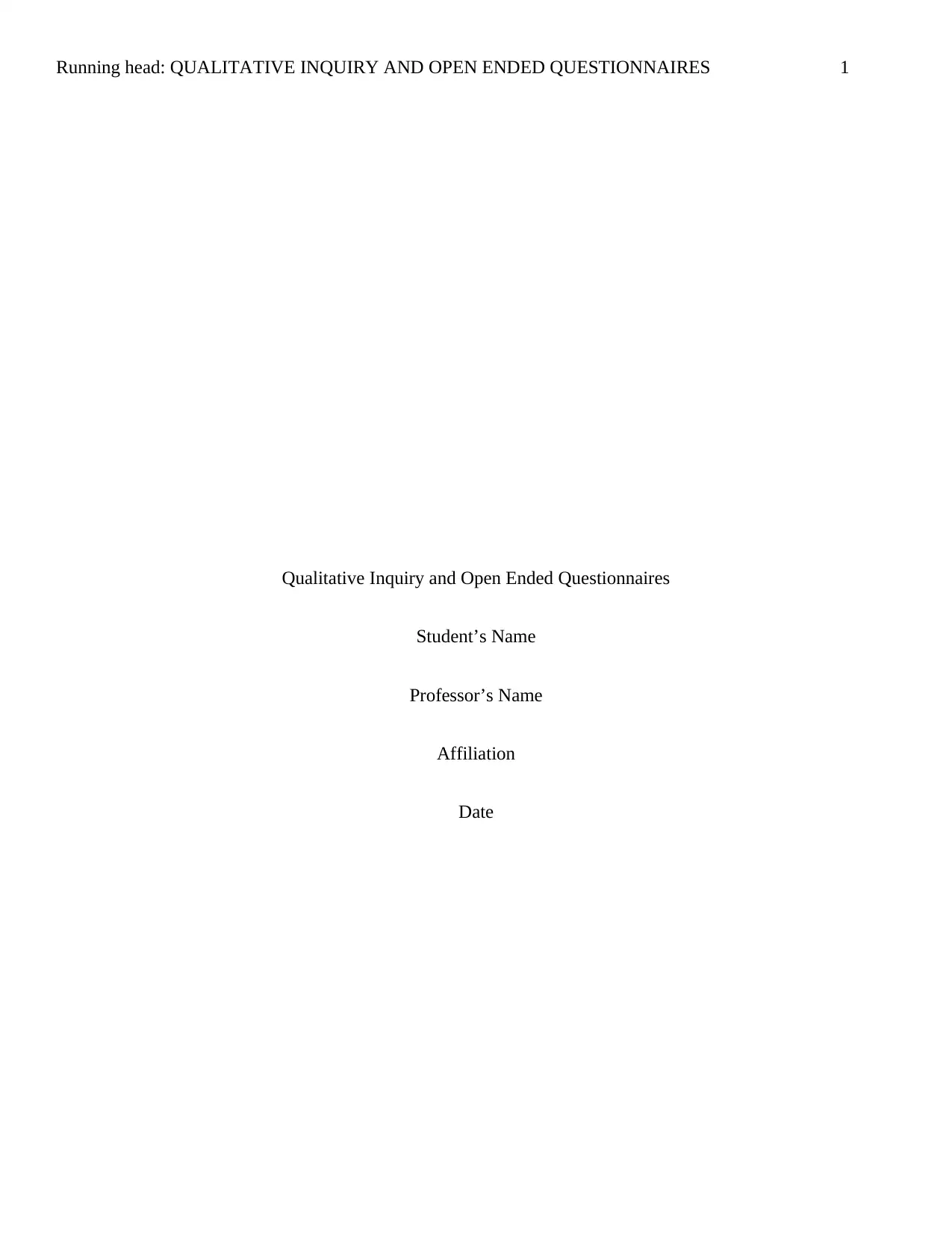
Running head: QUALITATIVE INQUIRY AND OPEN ENDED QUESTIONNAIRES 1
Qualitative Inquiry and Open Ended Questionnaires
Student’s Name
Professor’s Name
Affiliation
Date
Qualitative Inquiry and Open Ended Questionnaires
Student’s Name
Professor’s Name
Affiliation
Date
Paraphrase This Document
Need a fresh take? Get an instant paraphrase of this document with our AI Paraphraser
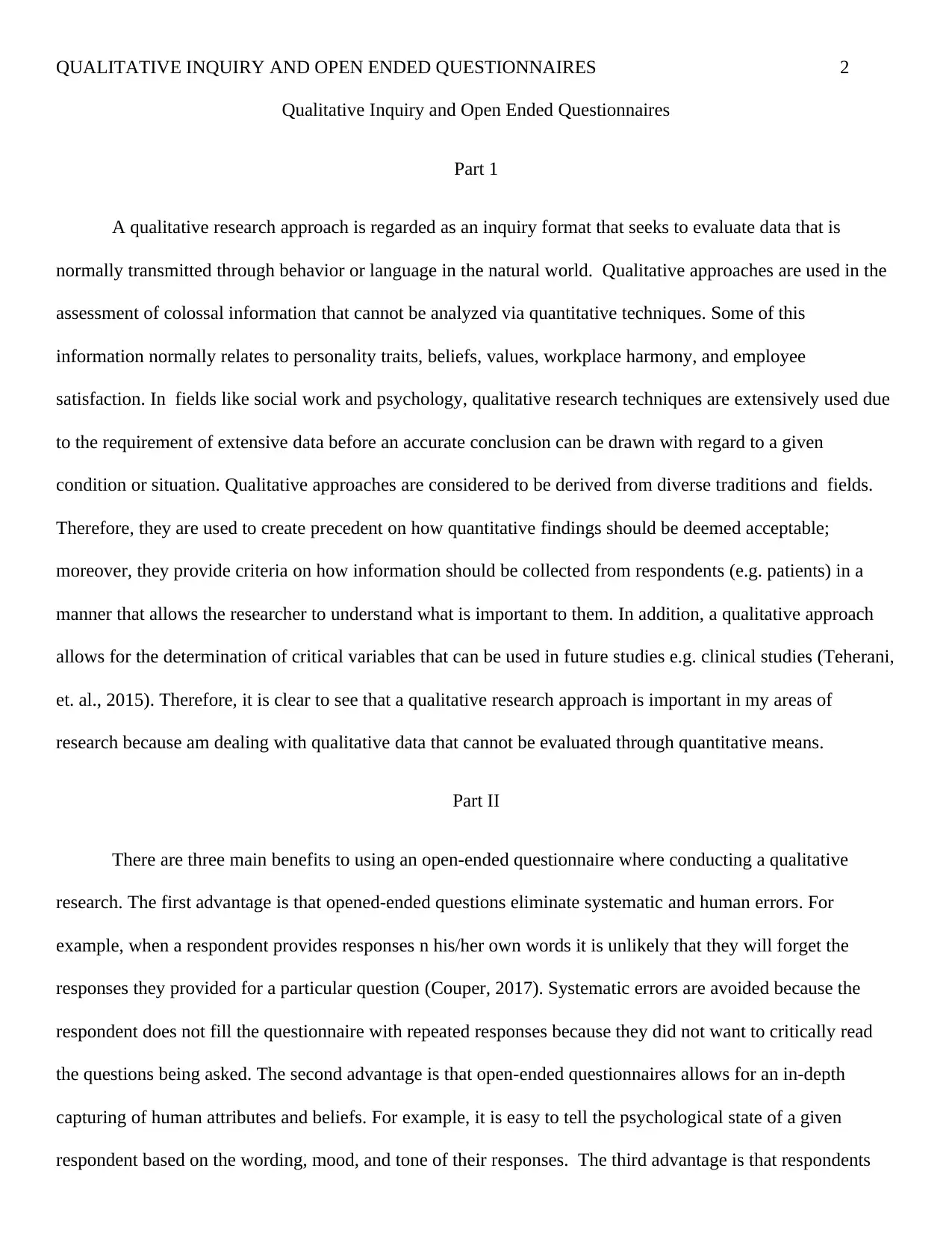
QUALITATIVE INQUIRY AND OPEN ENDED QUESTIONNAIRES 2
Qualitative Inquiry and Open Ended Questionnaires
Part 1
A qualitative research approach is regarded as an inquiry format that seeks to evaluate data that is
normally transmitted through behavior or language in the natural world. Qualitative approaches are used in the
assessment of colossal information that cannot be analyzed via quantitative techniques. Some of this
information normally relates to personality traits, beliefs, values, workplace harmony, and employee
satisfaction. In fields like social work and psychology, qualitative research techniques are extensively used due
to the requirement of extensive data before an accurate conclusion can be drawn with regard to a given
condition or situation. Qualitative approaches are considered to be derived from diverse traditions and fields.
Therefore, they are used to create precedent on how quantitative findings should be deemed acceptable;
moreover, they provide criteria on how information should be collected from respondents (e.g. patients) in a
manner that allows the researcher to understand what is important to them. In addition, a qualitative approach
allows for the determination of critical variables that can be used in future studies e.g. clinical studies (Teherani,
et. al., 2015). Therefore, it is clear to see that a qualitative research approach is important in my areas of
research because am dealing with qualitative data that cannot be evaluated through quantitative means.
Part II
There are three main benefits to using an open-ended questionnaire where conducting a qualitative
research. The first advantage is that opened-ended questions eliminate systematic and human errors. For
example, when a respondent provides responses n his/her own words it is unlikely that they will forget the
responses they provided for a particular question (Couper, 2017). Systematic errors are avoided because the
respondent does not fill the questionnaire with repeated responses because they did not want to critically read
the questions being asked. The second advantage is that open-ended questionnaires allows for an in-depth
capturing of human attributes and beliefs. For example, it is easy to tell the psychological state of a given
respondent based on the wording, mood, and tone of their responses. The third advantage is that respondents
Qualitative Inquiry and Open Ended Questionnaires
Part 1
A qualitative research approach is regarded as an inquiry format that seeks to evaluate data that is
normally transmitted through behavior or language in the natural world. Qualitative approaches are used in the
assessment of colossal information that cannot be analyzed via quantitative techniques. Some of this
information normally relates to personality traits, beliefs, values, workplace harmony, and employee
satisfaction. In fields like social work and psychology, qualitative research techniques are extensively used due
to the requirement of extensive data before an accurate conclusion can be drawn with regard to a given
condition or situation. Qualitative approaches are considered to be derived from diverse traditions and fields.
Therefore, they are used to create precedent on how quantitative findings should be deemed acceptable;
moreover, they provide criteria on how information should be collected from respondents (e.g. patients) in a
manner that allows the researcher to understand what is important to them. In addition, a qualitative approach
allows for the determination of critical variables that can be used in future studies e.g. clinical studies (Teherani,
et. al., 2015). Therefore, it is clear to see that a qualitative research approach is important in my areas of
research because am dealing with qualitative data that cannot be evaluated through quantitative means.
Part II
There are three main benefits to using an open-ended questionnaire where conducting a qualitative
research. The first advantage is that opened-ended questions eliminate systematic and human errors. For
example, when a respondent provides responses n his/her own words it is unlikely that they will forget the
responses they provided for a particular question (Couper, 2017). Systematic errors are avoided because the
respondent does not fill the questionnaire with repeated responses because they did not want to critically read
the questions being asked. The second advantage is that open-ended questionnaires allows for an in-depth
capturing of human attributes and beliefs. For example, it is easy to tell the psychological state of a given
respondent based on the wording, mood, and tone of their responses. The third advantage is that respondents
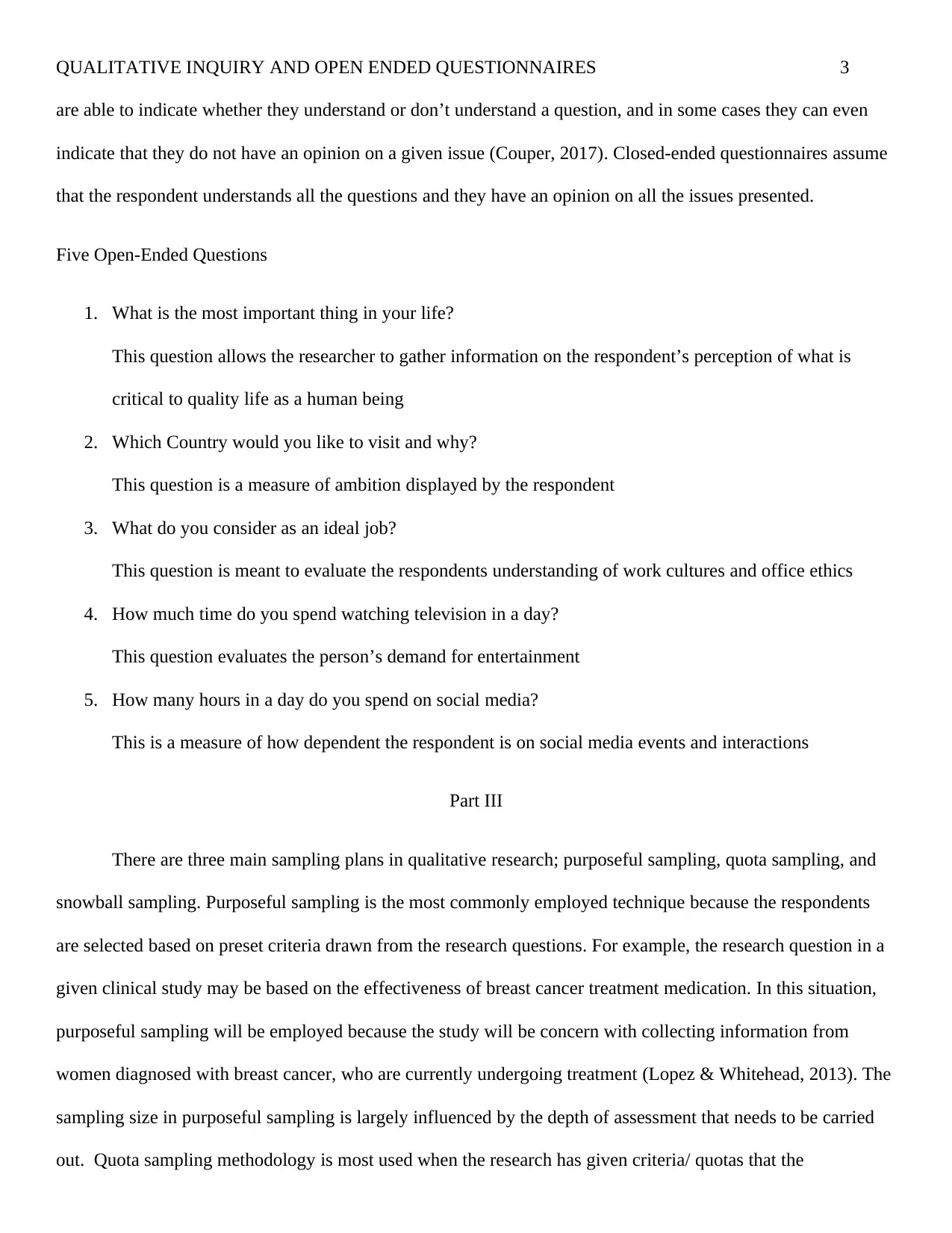
QUALITATIVE INQUIRY AND OPEN ENDED QUESTIONNAIRES 3
are able to indicate whether they understand or don’t understand a question, and in some cases they can even
indicate that they do not have an opinion on a given issue (Couper, 2017). Closed-ended questionnaires assume
that the respondent understands all the questions and they have an opinion on all the issues presented.
Five Open-Ended Questions
1. What is the most important thing in your life?
This question allows the researcher to gather information on the respondent’s perception of what is
critical to quality life as a human being
2. Which Country would you like to visit and why?
This question is a measure of ambition displayed by the respondent
3. What do you consider as an ideal job?
This question is meant to evaluate the respondents understanding of work cultures and office ethics
4. How much time do you spend watching television in a day?
This question evaluates the person’s demand for entertainment
5. How many hours in a day do you spend on social media?
This is a measure of how dependent the respondent is on social media events and interactions
Part III
There are three main sampling plans in qualitative research; purposeful sampling, quota sampling, and
snowball sampling. Purposeful sampling is the most commonly employed technique because the respondents
are selected based on preset criteria drawn from the research questions. For example, the research question in a
given clinical study may be based on the effectiveness of breast cancer treatment medication. In this situation,
purposeful sampling will be employed because the study will be concern with collecting information from
women diagnosed with breast cancer, who are currently undergoing treatment (Lopez & Whitehead, 2013). The
sampling size in purposeful sampling is largely influenced by the depth of assessment that needs to be carried
out. Quota sampling methodology is most used when the research has given criteria/ quotas that the
are able to indicate whether they understand or don’t understand a question, and in some cases they can even
indicate that they do not have an opinion on a given issue (Couper, 2017). Closed-ended questionnaires assume
that the respondent understands all the questions and they have an opinion on all the issues presented.
Five Open-Ended Questions
1. What is the most important thing in your life?
This question allows the researcher to gather information on the respondent’s perception of what is
critical to quality life as a human being
2. Which Country would you like to visit and why?
This question is a measure of ambition displayed by the respondent
3. What do you consider as an ideal job?
This question is meant to evaluate the respondents understanding of work cultures and office ethics
4. How much time do you spend watching television in a day?
This question evaluates the person’s demand for entertainment
5. How many hours in a day do you spend on social media?
This is a measure of how dependent the respondent is on social media events and interactions
Part III
There are three main sampling plans in qualitative research; purposeful sampling, quota sampling, and
snowball sampling. Purposeful sampling is the most commonly employed technique because the respondents
are selected based on preset criteria drawn from the research questions. For example, the research question in a
given clinical study may be based on the effectiveness of breast cancer treatment medication. In this situation,
purposeful sampling will be employed because the study will be concern with collecting information from
women diagnosed with breast cancer, who are currently undergoing treatment (Lopez & Whitehead, 2013). The
sampling size in purposeful sampling is largely influenced by the depth of assessment that needs to be carried
out. Quota sampling methodology is most used when the research has given criteria/ quotas that the
⊘ This is a preview!⊘
Do you want full access?
Subscribe today to unlock all pages.

Trusted by 1+ million students worldwide
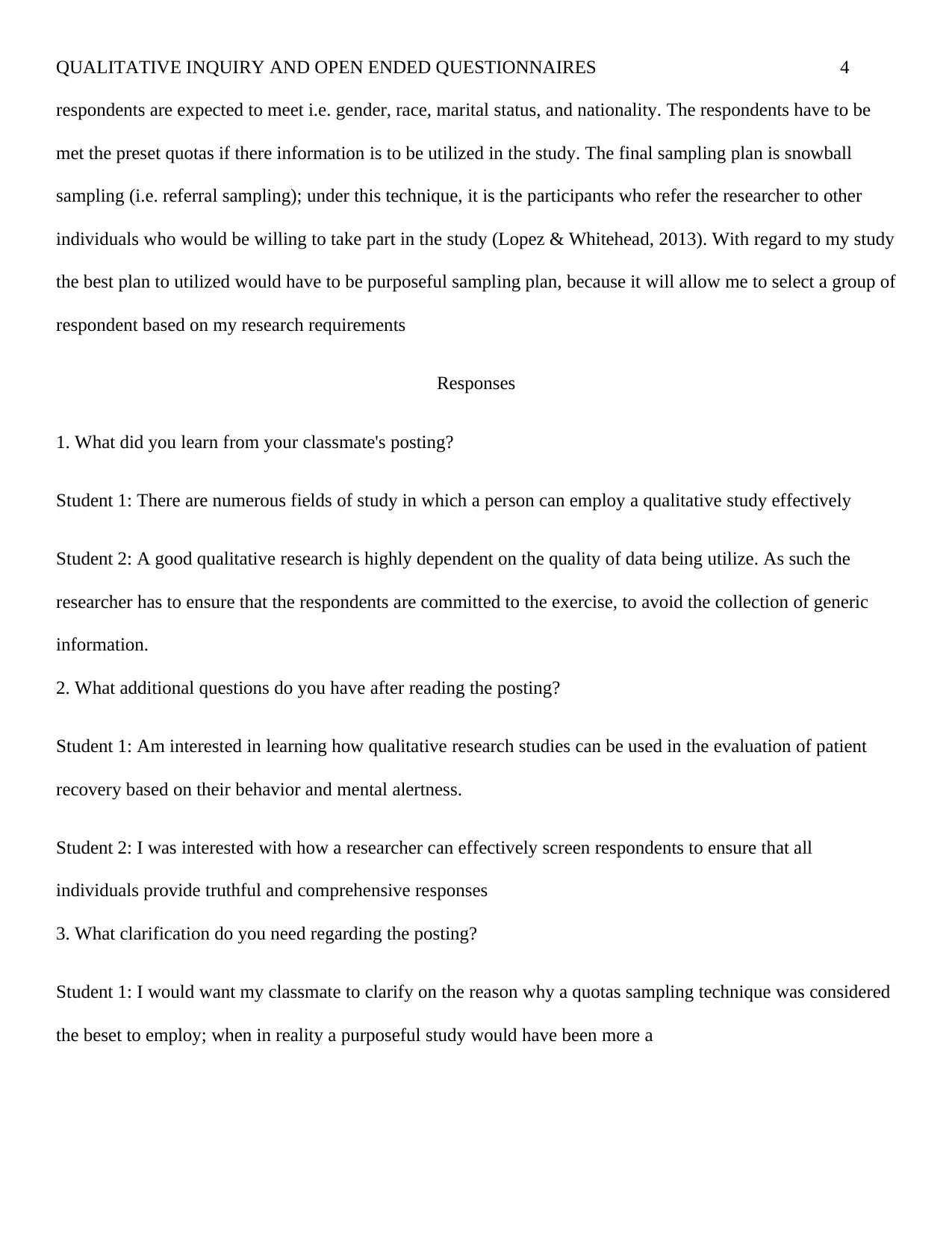
QUALITATIVE INQUIRY AND OPEN ENDED QUESTIONNAIRES 4
respondents are expected to meet i.e. gender, race, marital status, and nationality. The respondents have to be
met the preset quotas if there information is to be utilized in the study. The final sampling plan is snowball
sampling (i.e. referral sampling); under this technique, it is the participants who refer the researcher to other
individuals who would be willing to take part in the study (Lopez & Whitehead, 2013). With regard to my study
the best plan to utilized would have to be purposeful sampling plan, because it will allow me to select a group of
respondent based on my research requirements
Responses
1. What did you learn from your classmate's posting?
Student 1: There are numerous fields of study in which a person can employ a qualitative study effectively
Student 2: A good qualitative research is highly dependent on the quality of data being utilize. As such the
researcher has to ensure that the respondents are committed to the exercise, to avoid the collection of generic
information.
2. What additional questions do you have after reading the posting?
Student 1: Am interested in learning how qualitative research studies can be used in the evaluation of patient
recovery based on their behavior and mental alertness.
Student 2: I was interested with how a researcher can effectively screen respondents to ensure that all
individuals provide truthful and comprehensive responses
3. What clarification do you need regarding the posting?
Student 1: I would want my classmate to clarify on the reason why a quotas sampling technique was considered
the beset to employ; when in reality a purposeful study would have been more a
respondents are expected to meet i.e. gender, race, marital status, and nationality. The respondents have to be
met the preset quotas if there information is to be utilized in the study. The final sampling plan is snowball
sampling (i.e. referral sampling); under this technique, it is the participants who refer the researcher to other
individuals who would be willing to take part in the study (Lopez & Whitehead, 2013). With regard to my study
the best plan to utilized would have to be purposeful sampling plan, because it will allow me to select a group of
respondent based on my research requirements
Responses
1. What did you learn from your classmate's posting?
Student 1: There are numerous fields of study in which a person can employ a qualitative study effectively
Student 2: A good qualitative research is highly dependent on the quality of data being utilize. As such the
researcher has to ensure that the respondents are committed to the exercise, to avoid the collection of generic
information.
2. What additional questions do you have after reading the posting?
Student 1: Am interested in learning how qualitative research studies can be used in the evaluation of patient
recovery based on their behavior and mental alertness.
Student 2: I was interested with how a researcher can effectively screen respondents to ensure that all
individuals provide truthful and comprehensive responses
3. What clarification do you need regarding the posting?
Student 1: I would want my classmate to clarify on the reason why a quotas sampling technique was considered
the beset to employ; when in reality a purposeful study would have been more a
Paraphrase This Document
Need a fresh take? Get an instant paraphrase of this document with our AI Paraphraser
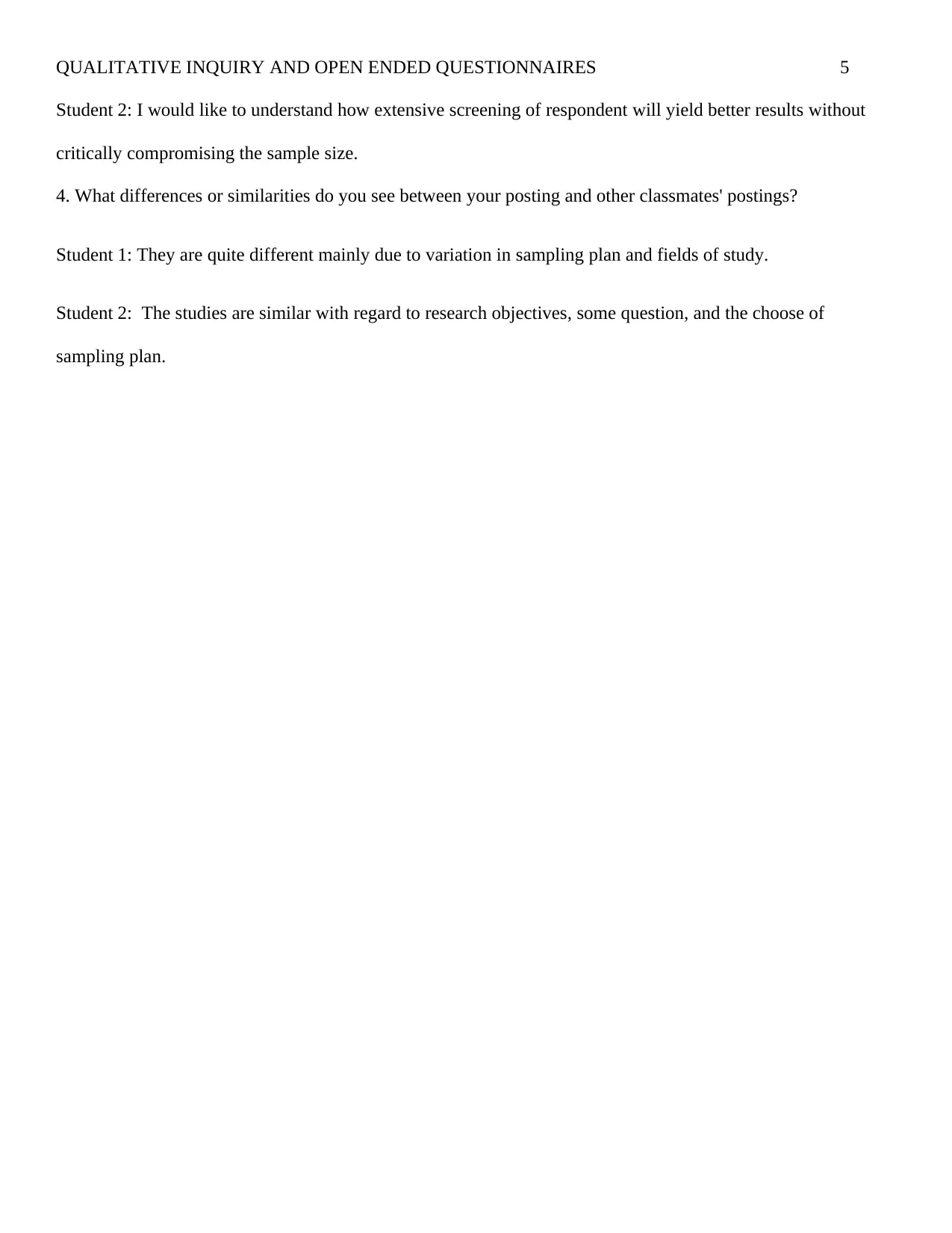
QUALITATIVE INQUIRY AND OPEN ENDED QUESTIONNAIRES 5
Student 2: I would like to understand how extensive screening of respondent will yield better results without
critically compromising the sample size.
4. What differences or similarities do you see between your posting and other classmates' postings?
Student 1: They are quite different mainly due to variation in sampling plan and fields of study.
Student 2: The studies are similar with regard to research objectives, some question, and the choose of
sampling plan.
Student 2: I would like to understand how extensive screening of respondent will yield better results without
critically compromising the sample size.
4. What differences or similarities do you see between your posting and other classmates' postings?
Student 1: They are quite different mainly due to variation in sampling plan and fields of study.
Student 2: The studies are similar with regard to research objectives, some question, and the choose of
sampling plan.
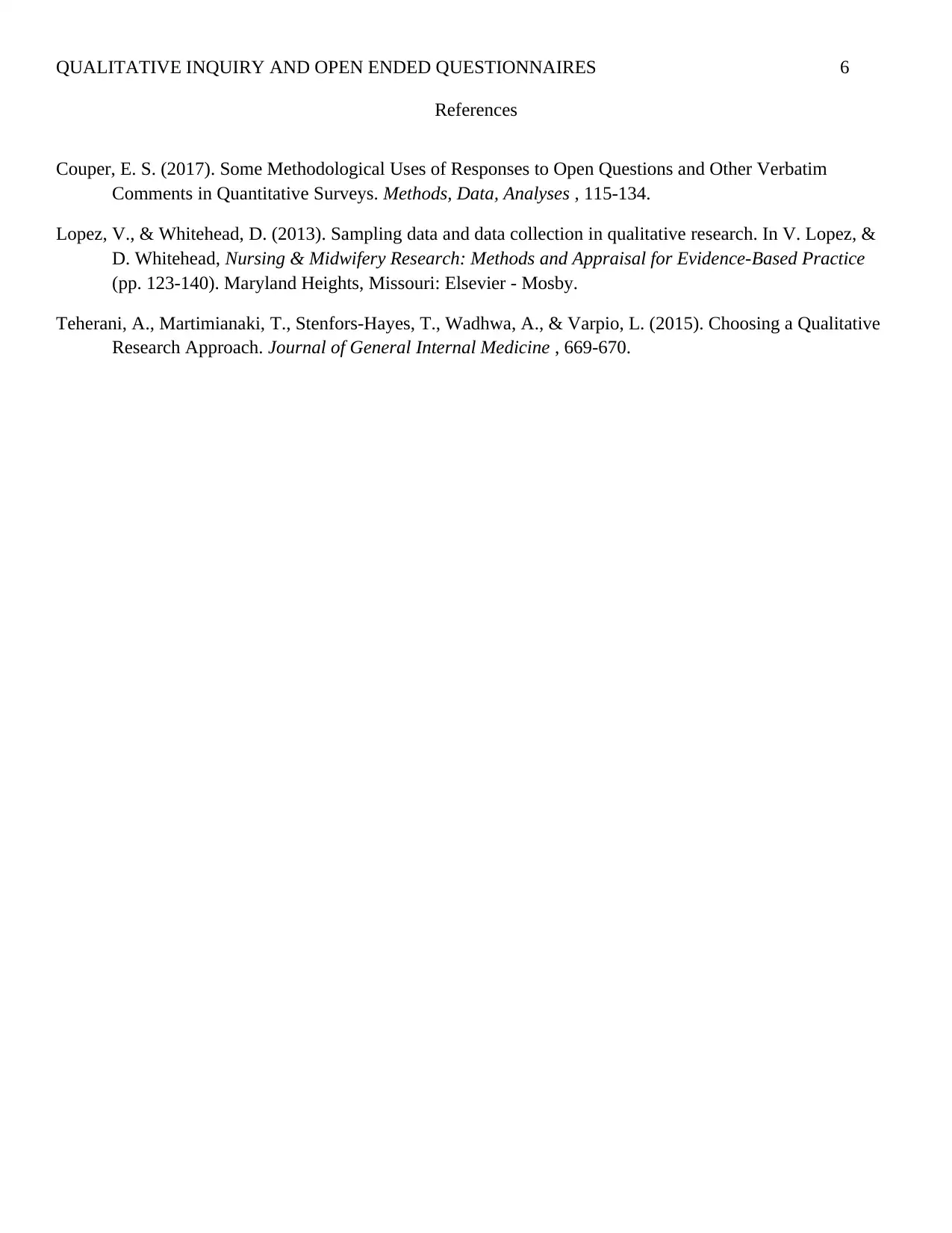
QUALITATIVE INQUIRY AND OPEN ENDED QUESTIONNAIRES 6
References
Couper, E. S. (2017). Some Methodological Uses of Responses to Open Questions and Other Verbatim
Comments in Quantitative Surveys. Methods, Data, Analyses , 115-134.
Lopez, V., & Whitehead, D. (2013). Sampling data and data collection in qualitative research. In V. Lopez, &
D. Whitehead, Nursing & Midwifery Research: Methods and Appraisal for Evidence-Based Practice
(pp. 123-140). Maryland Heights, Missouri: Elsevier - Mosby.
Teherani, A., Martimianaki, T., Stenfors-Hayes, T., Wadhwa, A., & Varpio, L. (2015). Choosing a Qualitative
Research Approach. Journal of General Internal Medicine , 669-670.
References
Couper, E. S. (2017). Some Methodological Uses of Responses to Open Questions and Other Verbatim
Comments in Quantitative Surveys. Methods, Data, Analyses , 115-134.
Lopez, V., & Whitehead, D. (2013). Sampling data and data collection in qualitative research. In V. Lopez, &
D. Whitehead, Nursing & Midwifery Research: Methods and Appraisal for Evidence-Based Practice
(pp. 123-140). Maryland Heights, Missouri: Elsevier - Mosby.
Teherani, A., Martimianaki, T., Stenfors-Hayes, T., Wadhwa, A., & Varpio, L. (2015). Choosing a Qualitative
Research Approach. Journal of General Internal Medicine , 669-670.
⊘ This is a preview!⊘
Do you want full access?
Subscribe today to unlock all pages.

Trusted by 1+ million students worldwide
1 out of 6
Related Documents
Your All-in-One AI-Powered Toolkit for Academic Success.
+13062052269
info@desklib.com
Available 24*7 on WhatsApp / Email
![[object Object]](/_next/static/media/star-bottom.7253800d.svg)
Unlock your academic potential
Copyright © 2020–2025 A2Z Services. All Rights Reserved. Developed and managed by ZUCOL.




